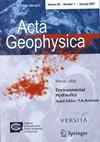Analysis on the seismogenic processes of East Anatolian Fault Zone and surrounding areas constrained by horizontal shifts in disturbing potential and modeling the density contrasts
Abstract
The Kahramanmaraş earthquakes on February 6, 2023, with magnitudes of 7.7 and 7.6, are considered the century's worst disaster in Türkiye. It was shown by these two main shocks that the East Anatolian Fault Zone not only often causes destructive earthquakes but also has a focus depth that is only about 10 km deep in the upper crust. The strength of the upper crust plays a crucial role in influencing the structures and fault zones of the upper crustal domain during seismic activities. This research explores the crustal deformation and structures of the East Anatolian Fault Zone and surrounding regions through gravity data and earthquake analysis. We began by calculating the radially averaged logarithmic amplitude spectrum of WGM12 (World Gravity Map 2012) isostatic residual gravity anomalies to determine the average depths of the deeper interfaces and the critical cut-off wavenumbers for filtering. The average depths of the Conrad discontinuity and the basement were determined to be 18 and 6.6 km, respectively, from the linear segments of the spectrum. A linear inversion method, specifically the weighted and damped minimum norm inverse solution, was applied to estimate density contrasts down to the Conrad depth. The present study thus carries out two-dimensional density contrast models of the East Anatolian Fault Zone and surrounding area in order to elucidate the structural discontinuities of the region. Furthermore, virtual deformation of the upper crust was mapped using horizontal shifts of the disturbing potential.

 求助内容:
求助内容: 应助结果提醒方式:
应助结果提醒方式:


